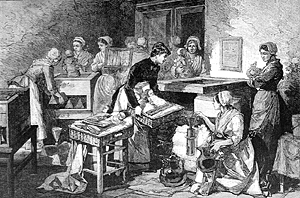 Engraving by Eugene Froment (1844-1900) |
Incubators for InfantsThe Illustrated London NewsPages 227-228, March 8, 1884 |
 Engraving by Eugene Froment (1844-1900) |
Incubators for InfantsThe Illustrated London NewsPages 227-228, March 8, 1884 |
In the accompanying Illustration the reader will find a representation of these incubators, which have been employed with great success as "La Maternité" since 1881, and which are now being introduced into other Paris hospitals. Science has long been preoccupied with the question of the treatment of feeble, and especially prematurely born, children. M. Tarnier's incubator is the latest contribution to the solution of the problem. One of these incubators employed at "La Maternité", the one on the old model, is composed of a wooden box, the sides of which are about 4 or 4 1/2 inches thick, hollow, and filled with sawdust for the sake of insulation. This box, resting on a stand 3 ft. high, is 27 inches broad and 31 inches deep; it is divided into two compartments by a central partition. In the upper compartment is placed the infant, and in the lower one a metal reservoir, containing about 15 gallons of hot water. To this reservoir is fitted a thermo-syphon, by means of which the water may be heated with gas, spirits of wine, or a petroleum lamp; and between the reservoir and the inclosing box a space is left for the circulation of air, which enters at the bottom of the box, rises as it becomes heated, and escapes through orifices in the lid of the box, which is fitted with a pane of glass. The upper compartment has, besides the movable glass lid, a lateral door, through which to slide the cradle in and out; and it is separated from the lower compartment by a board pierced with holes, through which the warm air penetrates. The temperature of the upper compartment thus heated is maintained at about 89 1/2 deg. Fahrenheit. At the Lariboisière hospital 93 deg. Fahrenheit are taken as the standard; but this question of the temperature to be preferred has not yet been definitely settled. As regards the means of heating the incubator, gas is employed at the Hôpital de la Charité, and an electrical alarm-bell attached to a Regnard regulator rings when the temperature rises beyond a certain point.
The second model of incubator employed by M. Tarnier, and also represented in our Illustration, is much simple and cheaper, and less bulky. It consists simply of a wooden box 25 in. long, 14 in. broad, and 20 in. high, outside measurement. The wood is one inch thick, and may be coated with felt or padded inside. This box is divided into two parts by a board, some 4 in. shorter than the box, and placed at a height of 6 in. from the bottom. In the lower compartment are two lateral openings fitted with sliding doors; one, which can never be completely closed, gives passage to the air; the other is for the introduction of the stone bottles containing hot water, called in Paris moines, which are employed to heat the apparatus. The upper compartment, covered by a closely-fitted glass lid, receives the infant, and at one end is an orifice, furnished with a chimney and a revolving ventilator, through which the air escapes. In the opening that separates the two compartments is hung a thermometer with a wet sponge to moisten the air. The air enters at the bottom, passes over the bottles of hot water, rises into the upper compartment, passes over the whole length of the infant, and so out the orifice at the end. The hot-water bottles hold each somewhat above a pint, and five of them may be placed in the incubator, but it is generally found that four suffice to maintain a temperature of 88 deg. To 89 1/2 deg. Fahrenheit, the temperature of the room being 62 deg. to 66 deg. The heating is continued by changing one of the bottles about every two hours, and with this system there is no danger of overheating. This incubator is so simple that any village carpenter can make it, and cheap enough to be within the means of all but the most destitute. The infants placed in incuabators at "La Maternité," if they are strong enough, are fed by nurses, or else with asses' milk, administered with a spoon, the feeding bottle being prohibited in this establishment. The operations of feeding, washing, and dressing the infants placed in the incubators are performed in the room at the ordinary temperature of 62 deg. to 66 deg., for the infants do not appear to be any more sensitive than other infants, and exposure to the air for a short period does them no harm. The infant in the incubator is dressed in ordinary swaddling clothes. The results obtained at "La Maternité" by the employment of incubators have been very satisfactory.